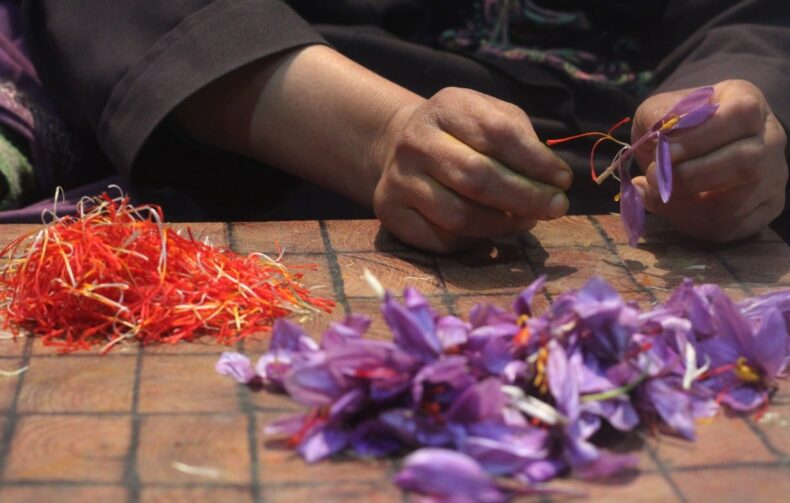Indoor farming for cultivating one of the world’s most expensive spices in the Himalayan region as climate change affects the production of precious saffron in Indian-controlled Kashmir.
According to specialists, laboratory results have been encouraging, and the technique has been introduced to more than a dozen conventional producers.
Nazir Ahmed Ganai, an agricultural expert, claimed that indoor cultivation is assisting in boosting saffron production, which has recently been negatively impacted by environmental changes.
“We are attempting to determine how we can adapt ourselves if the climate is confronting us.” Going indoors entails vertical farming, according to Ganai, who also serves as vice chancellor of the primary agricultural university in the area.

About Saffron
A spice called Saffron is made from the Crocus sativus flower, a relative of the lily. The stigma and styles, often known as threads, found inside the flower are where saffron is produced from.
Because of the difficulty in harvesting, saffron is quite expensive. Each flower’s tiny threads must be manually removed by farmers.
The saffron flavor is then enhanced by heating and curing the threads. Saffron is one of the most costly spices in the world due to the additional work required.
Saffron Production in Kashmir
Jammu and Kashmir, a union territory, has historically been the only place where saffron can be produced.
The biggest producer of saffron is the Pampore region, sometimes known as the “Saffron Bowl of Kashmir.”

One of India’s designated Globally Important Agricultural Heritage Systems (GIAHS) sites is the Pampore Saffron Heritage of Kashmir. Budgam, Srinagar, and Kishtwar are additional saffron-producing districts.
Economy of Kashmir
The majority of Kashmir’s economy is based on agriculture, and as the effects of climate change, such as rising temperatures and irregular rainfall patterns, worsen, farmers there are becoming more concerned about their ability to produce as much food.
The numerous glaciers in the area have also been affected by the changes, swiftly receding, which has hampered traditional farming practices in the ecologically vulnerable area.
Production and export have also been hampered by regional conflict. In Kashmir, a region that is split between India and Pakistan and is claimed by both, a separatist movement has struggled against Indian rule for decades. The violence has claimed the lives of tens of thousands of civilians, insurgents, and security personnel.
The price of the spice can reach $4,000 for a kilogram, in part because it requires up to 150,000 blossoms to create that much.
Health benefits of saffron
- Contains several Antioxidants
Saffron’s red color comes from the antioxidants crocin and crocetin, which are also known to shield the brain’s cells from long-term harm. The unique flavor and aroma come from the antioxidant safranal, which is also believed to improve memory and learning.
- Helps in various disorders
A variety of conditions, including cognitive and memory problems, hypertension, stomach ailments, and coronary artery illnesses, can be successfully treated with saffron. Neurodegenerative conditions including Alzheimer’s and Parkinson’s disease are helped by it.
- Helps with PMS symptoms
Saffron may be useful in alleviating premenstrual (PMS) symptoms like irritability, headaches, and cravings, according to studies. For 20 minutes, 35 women with a normal sense of smell participated in a study that was published in the journal Phytomedicine. The treatment of PMS, dysmenorrhea, and irregular menstruation were discovered to be affected to some extent by the odor.
- Helps in Weight Loss
According to studies, saffron reduces appetite and body mass index (BMI), waist circumference, and total body fat mass, which helps prevent snacking.
Also read: India – World’s biggest rice exporter all set not to share rice from its food basket for exports













